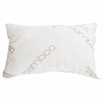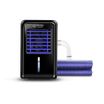- Product Description
- About FjallRaven
Simple, robust trekking backpack for daytrips and shorter overnight treks, all year round. Made from G-1000 HeavyDuty Eco in recycled polyester and organic cotton. The durable fabric gives a timeless impression and can be waxed with Greenland Wax for extra resistance against moisture and wear. The carrying system has a fixed back length and is stable and substantial for the backpack\x92s size. The hipbelt and shoulder straps are adapted to fit a woman\x92s body type and the hipbelt has two pockets for sun screen, snacks or the like. The backpack is top loaded and has a spacious main compartment with snow lock. The top lid can be raised and has two pockets. There is an attachment loop for an ice axe and trekking poles and the backpack is hydration system compatible. A zippered pocket at the front holds rain gear and the like, and there are two side pockets. Compression straps on the sides stabilise the contents of the pack when it is not fully loaded. Whistle on the chest strap and base made from durable polyamide. A rain cover in visible safety colour UN Blue is included
FEATURES:
- Simple, robust trekking backpack.
- G-1000 HeavyDuty Eco.
- Supportive carrying system with fixed back length and robust hipbelt.
- The backpack is top loaded and has a spacious main compartment with snow lock.
- The top lid can be raised and has two pockets.
SPECIFICATION:
- Outer material: 500D 100% Polyamide, G-1000 HeavyDuty Eco: 65% polyester, 35% cotton
- Gender: Female
- Concept: Trekking
- Height: 65 cm
- Width: 32 cm
- Depth: 27 cm
- Weight: 1600 g
- Volume: 38 L
- Non Textile Parts of Animal Origin: Yes
- Volume: 38 L
- Rain-cover: 1
- Laptop pocket: No
- Carrying system: Fixed
Making adventure last since 1960
In the 1950’s, 14 year-old Ake Nordin from Ornskoldsvik in Northern Sweden spent more time outdoors than indoors. After many long treks in the mountains, Ake decided the backpacks at the time were unsatisfactory and took matters into his own hands by building a wooden frame. This evenly distributed weight across his back so the pack did not end up uneven, pear-shaped, and uncomfortable. It also meant he could carry more weight with ease. Ake’s innovation quickly caught on and in 1960 Fjallraven became the first to commercially make and distribute framed backpacks.
Fjallraven means Arctic Fox in Swedish, honoring the small and highly adaptable predator that lives in the Swedish mountains under the harshest conditions. From the small town of Ornskoldsvik, Fjallraven has now expanded to every corner in the world. The fundamental ideas remain the same; provide functional, durable, and timeless equipment to make the outdoors more enjoyable for all. We continue to find smart, innovative solutions to make every adventure an unforgettable one.
AN IDEA THAT CARRIED WEIGHT
Ake built his first framed backpack in his basement with his mother’s sewing machine. Using strong cotton fabric for the pack, he attached the wooden frame using leather straps and used calfskin for the support straps. Not only was the pack more comfortable and distributed weight evenly, it also increased ventilation between his back and the pack. Soon after, during a trip up North, Ake’s invention caught the attention of the indigenous Sami people who spent weeks at a time high up in the mountains. They asked Ake to build them a backpack and after that a tent. Fjallraven had found its beginning.
OUR PRINCIPLES
Rule 1: Functionality We work hard to develop functional equipment by carefully considering everything from new smart solutions to improved material. Our goal is to offer outdoor equipment that allows you to spend more – and more enjoyable – time in nature.
Rule 2: Durability A Fjallraven product is a guarantee that you will not need to buy a new product for a long, long time. Our users know that our products live up to strict requirements and last for a long time. Many products last for generations. This long lifecycle depends on many factors - for example production experience, superior choice of material, product assembly and strict quality controls during the production process.
Rule 3: Dependability When we design our products, we choose material and solutions that combined give you a safe, dependable product you will be able to use outdoors. We are aware that our equipment might be used in situations where there is not a lot of room for error, which is why all of our products are tested by experienced test groups before being sent to our retailers.
OUR RESPONSIBILITY
Fjallraven is growing and constantly moving into new markets. This makes it all the more important for us to take responsibility for every decision we make, whether we are in our home in Ornskoldsvik in northern Sweden or another corner of the world. One of the most important aspects of this is our responsibility toward everyone that works in the development and production of our equipment.





















































 Like Us on Facebook
Like Us on Facebook Follow Us on Twitter
Follow Us on Twitter Watch Us on YouTube
Watch Us on YouTube Read Our Blog
Read Our Blog
